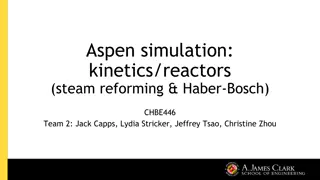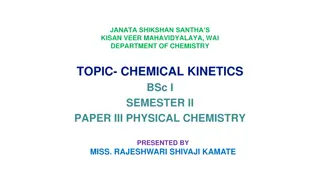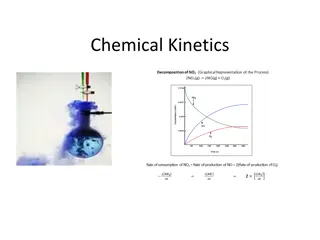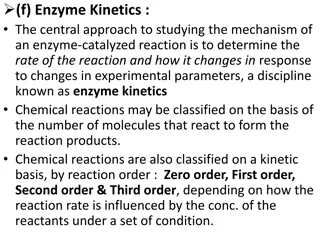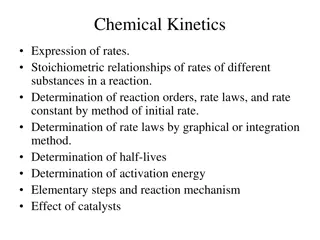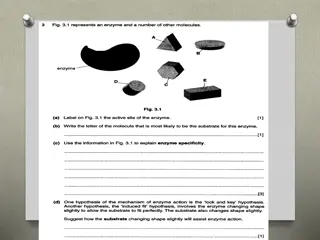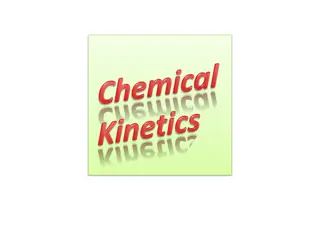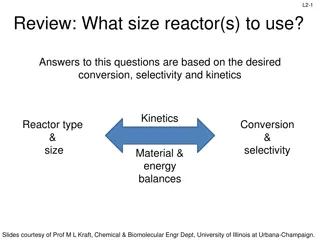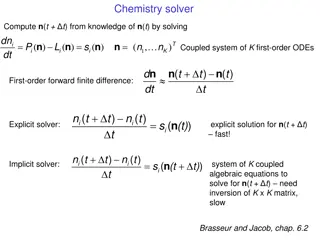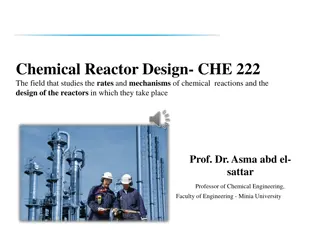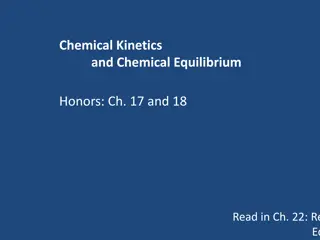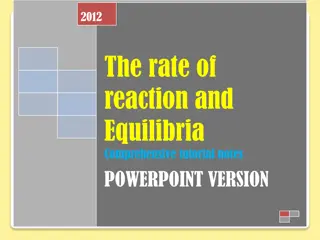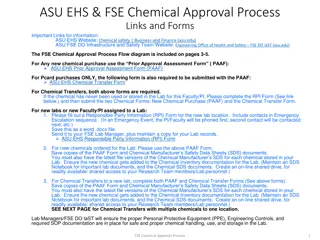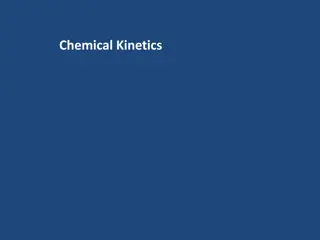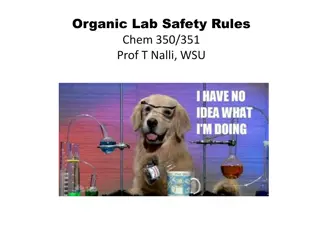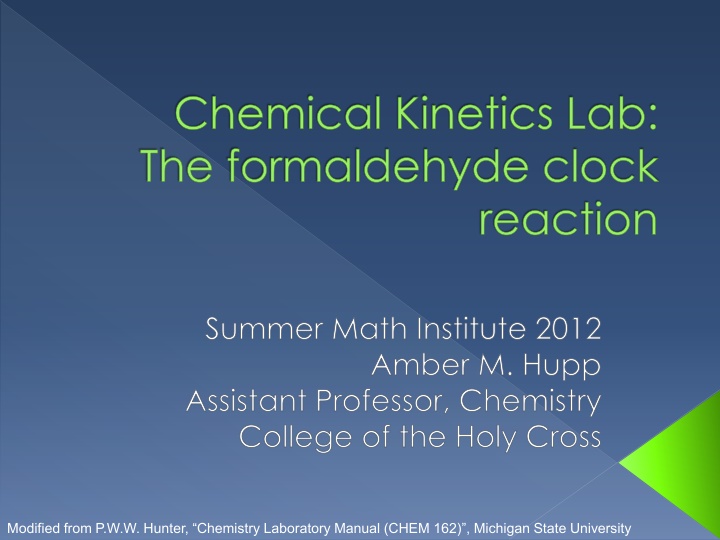
Chemical Kinetics: Clock Reactions and Reaction Mechanisms
Explore the fascinating world of chemical kinetics through clock reactions and reaction mechanisms. Learn how the rate of a reaction is determined by its slowest step, and discover the concept of clock reactions where a visible change marks a specific point in the reaction. Delve into the formaldehyde-bisulfite reaction as a simpler example of a clock reaction and understand how reaction rates depend on the initial concentrations of reactants. Gain insights into the intricacies of chemical reactions and the factors that influence their speed.
Download Presentation

Please find below an Image/Link to download the presentation.
The content on the website is provided AS IS for your information and personal use only. It may not be sold, licensed, or shared on other websites without obtaining consent from the author. If you encounter any issues during the download, it is possible that the publisher has removed the file from their server.
You are allowed to download the files provided on this website for personal or commercial use, subject to the condition that they are used lawfully. All files are the property of their respective owners.
The content on the website is provided AS IS for your information and personal use only. It may not be sold, licensed, or shared on other websites without obtaining consent from the author.
E N D
Presentation Transcript
Chemical Kinetics Lab: The formaldehyde clock reaction Summer Math Institute 2012 Amber M. Hupp Assistant Professor, Chemistry College of the Holy Cross Modified from P.W.W. Hunter, Chemistry Laboratory Manual (CHEM 162) , Michigan State University
Thermodynamics or Kinetics? Thermodynamics if a reaction occurs Kinetics how fast the reaction occurs and route the reaction takes Examples : how fast unwanted chemical substances break down (environmental) how long before chemicals like drugs metabolize in the body(biological) how fast will this fuel ignite to run my car (energy!)
Reaction Mechanisms Tells us how the reaction proceeds Chemical reactions occur through a series of steps (intermediate reactions) Some steps are fast, some slow Slowest step in mechanism determines rate Can t go any faster than slowest step!
Clock Reactions A visible change occurs when a certain point in the reaction is reached (typically the end point) Time is inversely proportional to rate The longer a reaction takes, the slower the rate must be Something we can measure in the lab!
Clock Reaction Demonstration This is a complicated clock reaction called the Briggs-Rauscher Reaction Goes through 10 to 15 cycles Chemical oscillator is due to changes in iodine and iodide ion concentrations in solution (several chemical equations) B.Z. Shakhashiri, Chemical Demonstrations: A handbook for Teachers of Chemistry, V2, 1983, p248
Formaldehyde-Bisulfite Reaction A simpler example of a clock reaction Step 1: HSO3- + H2O Step 2: H2O + HCHO + SO32- CH2(OH)SO3- + OH- Slow SO32- + H3O+ Fast Produce OH- (basic!) Can use pH indicator phenolphthalein Colorless to pink at certain pH Modified from P.W.W. Hunter, Chemistry Laboratory Manual (CHEM 162) , Michigan State University B.Z. Shakhashiri, Chemical Demonstrations: A handbook for Teachers of Chemistry, V4, 1983, p70
Rate of F-BS reaction Rates depend on initial concentrations of reactants A change in either one will affect reaction rate Rate = k [formaldehyde]a [bisulfate-sulfite]b The order of each reactant (a & b) add to give the overall reaction order
Orders of Reactions what do they mean? For the general reaction X Z Say a reaction is first order in X Then as the concentration of X doubles, the rate also doubles Say a reaction is second order in X Then as the concentration of X doubles, the rate quadruples Shows concentration dependence on rate
How to calculate the order of the reaction? Rate = k [formaldehyde]a [bisulfate-sulfite]b Hard to understand what to change and what to hold constant so let s rearrange by taking log of both sides log(rate) = log(k) + a log[formaldehyde] + b log[bisulfate-sulfite] If the concentration of F is held constant, then (a log[F] ) is constant and we can plot log(rate) vs (b log[BS]) to get order with respect to BS
Experimental Set-up The concentrations of each reactant will be varied, while holding the other reactant constant. The time for each reaction to go to completion (in seconds), via a color change of phenolphthalein, will be recorded in the table. Reaction Time (s) 31.6 31.2 31.7 31.9 15.8 7.9 5.0 3.5 Trial [F] (mL) [BS-S] (mL) Rate (1/s) 1 2 3 4 5 6 7 8 5 5 5 5 5 10 15 20 2.5 5 10 15 5 5 5 5 T. Cassen, J. Chem. Ed. 53(3), 1976, pg 197
Experimental Results Reaction Rate (1/s) 0.03165 0.03205 0.0315 0.03135 Trial [BS-S] (mL) log[BS-S] log(rate) 1 2 3 4 2.5 5 10 15 0.399 0.698 1.0 1.17 -1.499 -1.494 -1.500 -1.500 Reaction Rate (1/s) 0.0632 0.1265 0.200 0.285 Trial [F] (mL) log[F] log(rate) 5 6 7 8 5 10 15 20 0.698 1.0 1.17 1.30 -1.19 -0.897 -0.699 -0.544
Graphs 0 -0.4 Log (rate) -0.8 -1.2 -1.6 0 0.5 1 1.5 2 Log[BS]
Graphs 0 y = 1.0697x - 1.9472 -0.4 Log (rate) -0.8 -1.2 -1.6 0 0.2 0.4 0.6 0.8 1 1.2 1.4 Log[F]
Conclusions Reactant F BS-S Slope of line 1 0 Overall reaction order: Order 1 0 1 Order of overall reaction is one. Reaction depends directly on concentration of formaldehyde, but does not depend on bisulfite B.Z. Shakhashiri, Chemical Demonstrations: A handbook for Teachers of Chemistry, V4, 1983, p70
Points of interest Dependent vs independent variables Calculation of slope Using log function to simplify expression Significant figures/digits Fluctuation in measurement/results Can perform experiment if desired and use discovery style

